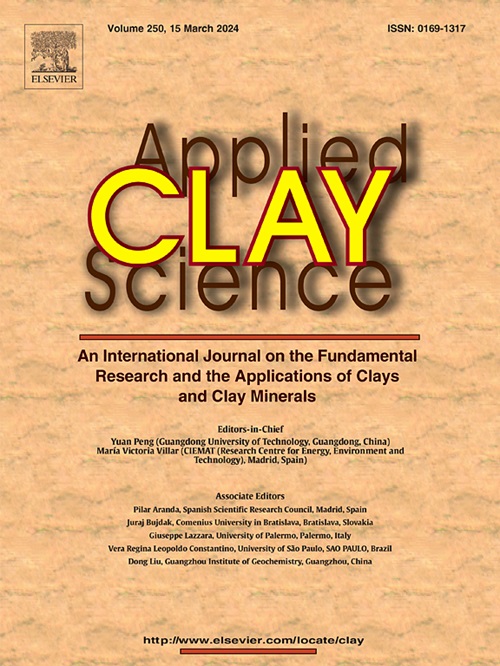先进的OER催化剂:MnCo-LDH与NiP2和Ni5P4金属磷化物集成,具有优异的水分解性能
IF 5.3
2区 地球科学
Q2 CHEMISTRY, PHYSICAL
引用次数: 0
摘要
析氧反应(OER)是水分解的关键步骤,对可再生能源系统至关重要。本研究提出了由锰钴层状双氢氧化物(MnCo-LDH)与磷化镍(NiP2和Ni5P4)集成的新型OER电催化剂。通过电化学沉积在钢基体上逐层制备MnCo-LDH@NiP2和MnCo-LDH@Ni5P4复合材料。通过x射线衍射(XRD)、扫描电子显微镜(SEM)和x射线光电子能谱(XPS)的表征证实了复合材料的成功形成和集成。MnCo-LDH@NiP2和MnCo-LDH@Ni5P4电极在100 mA cm - 2下的过电位分别为276 mV和318 mV,明显低于MnCo-LDH单独的423 mV。与MnCo-LDH的84.0 mV dec−1相比,MnCo-LDH@NiP₂的Tafel斜率为53.2 mV dec−1,MnCo-LDH@Ni5P4的Tafel斜率为60.9 mV dec−1,表明反应动力学增强。电化学阻抗谱(EIS)显示,MnCo-LDH@NiP₂(0.62 Ω cm2)和MnCo-LDH@Ni5P4 (0.77 Ω cm2)的电荷转移电阻(Rct)降低,优于MnCo-LDH (1.01 Ω cm2)。这些发现以及稳定性测试的结果突出了MnCo-LDH与磷化镍集成作为高效稳定的OER催化剂的潜力。本文章由计算机程序翻译,如有差异,请以英文原文为准。
Advanced OER catalysts: MnCo-LDH integrated with NiP2 and Ni5P4 metal phosphides for superior water splitting performance
The oxygen evolution reaction (OER) is a critical step in water splitting, essential for renewable energy systems. This study presented advanced OER electrocatalysts composed of manganese‑cobalt layered double hydroxides (MnCo-LDH) integrated with nickel phosphides (NiP2 and Ni5P4). The MnCo-LDH@NiP2 and MnCo-LDH@Ni5P4 composites were synthesized via layer-by-layer electrochemical deposition on steel substrates. Characterization through X-ray diffraction (XRD), scanning electron microscopy (SEM), and X-ray photoelectron spectroscopy (XPS) confirmed the successful formation and integration of the composites. The MnCo-LDH@NiP2 and MnCo-LDH@Ni5P4 electrodes demonstrated superior OER activity with overpotentials of 276 mV and 318 mV at 100 mA cm−2, respectively, significantly lower than 423 mV for MnCo-LDH alone. Tafel slopes of 53.2 mV dec−1 for MnCo-LDH@NiP₂ and 60.9 mV dec−1 for MnCo-LDH@Ni5P4 indicated enhanced reaction kinetics compared to 84.0 mV dec−1 for MnCo-LDH. Electrochemical impedance spectroscopy (EIS) showed reduced charge transfer resistance (Rct) for MnCo-LDH@NiP₂ (0.62 Ω cm2) and MnCo-LDH@Ni5P4 (0.77 Ω cm2), outperforming MnCo-LDH (1.01 Ω cm2). These findings along with the results from stability test highlighted the potential of MnCo-LDH integrated with nickel phosphides as highly efficient and stable OER catalysts.
求助全文
通过发布文献求助,成功后即可免费获取论文全文。
去求助
来源期刊

Applied Clay Science
地学-矿物学
CiteScore
10.30
自引率
10.70%
发文量
289
审稿时长
39 days
期刊介绍:
Applied Clay Science aims to be an international journal attracting high quality scientific papers on clays and clay minerals, including research papers, reviews, and technical notes. The journal covers typical subjects of Fundamental and Applied Clay Science such as:
• Synthesis and purification
• Structural, crystallographic and mineralogical properties of clays and clay minerals
• Thermal properties of clays and clay minerals
• Physico-chemical properties including i) surface and interface properties; ii) thermodynamic properties; iii) mechanical properties
• Interaction with water, with polar and apolar molecules
• Colloidal properties and rheology
• Adsorption, Intercalation, Ionic exchange
• Genesis and deposits of clay minerals
• Geology and geochemistry of clays
• Modification of clays and clay minerals properties by thermal and physical treatments
• Modification by chemical treatments with organic and inorganic molecules(organoclays, pillared clays)
• Modification by biological microorganisms. etc...
 求助内容:
求助内容: 应助结果提醒方式:
应助结果提醒方式:


